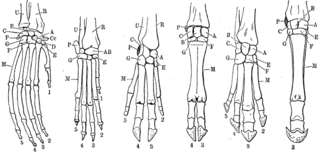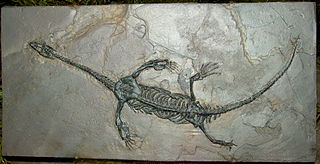
Quadrupedalism is a form of terrestrial locomotion where a tetrapod animal uses all four limbs (legs) to bear weight, walk, and run. An animal or machine that usually maintains a four-legged posture and moves using all four limbs is said to be a quadruped. Most quadrupeds are terrestrial vertebrates, including mammals and reptiles, though some are largely aquatic such as turtles, amphibians, and pinnipeds.

Tetrapods are four-limbed animals constituting the superclass Tetrapoda. It includes extant and extinct amphibians, reptiles, and synapsids. Tetrapods evolved from a group of animals known as the Tetrapodomorpha which, in turn, evolved from ancient sarcopterygian fish around 390 million years ago in the middle Devonian period; their forms were transitional between lobe-finned fishes and the four-limbed tetrapods. The first tetrapods appeared by the late Devonian, 367.5 million years ago. The specific aquatic ancestors of the tetrapods and the process by which they colonized Earth's land after emerging from water remains unclear. The change from a body plan for breathing and navigating in water to a body plan enabling the animal to move on land is one of the most profound evolutionary changes known. The first tetrapods were primarily aquatic. Modern amphibians, which evolved from earlier groups, are generally semiaquatic; the first stage of their lives is as fish-like tadpoles, and later stages are partly terrestrial and partly aquatic. However, most tetrapod species today are amniotes, most of those are terrestrial tetrapods whose branch evolved from earlier tetrapods about 340 million years ago. The key innovation in amniotes over amphibians is the ability for the eggs to retain their aqueous contents on land, rather than needing to stay in water.

In biology, dactyly is the arrangement of digits on the hands, feet, or sometimes wings of a tetrapod animal. It comes from the Greek word δακτυλος (dáktylos) = "finger".

Ichthyostega is an early genus of tetrapodomorphs that lived at the end of the Late Devonian Period. It was one of the first four-limbed vertebrates in the fossil record. Ichthyostega possessed lungs and limbs that helped it navigate through shallow water in swamps. Although Ichthyostega is often labelled a "tetrapod" due to the possession of limbs and fingers, it was more basal ("primitive") than true crown-tetrapods, and could more accurately be referred to as a stegocephalian or stem tetrapod. Likewise, while undoubtedly of amphibian build and habit, it is not considered a true member of the group in the narrow sense, as the first modern amphibians appeared in the Triassic Period. Until finds of other early stegocephalians and closely related fishes in the late 20th century, Ichthyostega stood alone as a transitional fossil between fish and tetrapods, combining fish- and tetrapod-like features. Newer research has shown that it had an unusual anatomy, functioning more akin to a seal than a salamander, as previously assumed.

A flipper is a broad, flattened limb adapted for aquatic locomotion. It refers to the fully webbed, swimming appendages of aquatic vertebrates that are not fish.

Labyrinthodontia is an extinct amphibian subclass, which constituted some of the dominant animals of late Paleozoic and early Mesozoic eras. The group evolved from lobe-finned fishes in the Devonian and is ancestral to all extant landliving vertebrates. As such it constitutes an evolutionary grade rather than a natural group (clade). The name describes the pattern of infolding of the dentin and enamel of the teeth, which are often the only part of the creatures that fossilize. They are also distinguished by a heavily armoured skull roof, and complex vertebrae, the structure of which were used in older classifications of the group.

A forelimb or front limb is one of the paired articulated appendages (limbs) attached on the cranial (anterior) end of a terrestrial tetrapod vertebrate's torso. With reference to quadrupeds, the term foreleg or front leg is often used instead. In bipedal animals with an upright posture, the term upper limb is often used.

Diadectidae is an extinct family of early tetrapods that lived in what is now North America and Europe during the Late Carboniferous and Early Permian, and in Asia during the Late Permian. They were the first herbivorous tetrapods, and also the first fully terrestrial animals to attain large sizes. Footprints indicate that diadectids walked with an erect posture. They were the first to exploit plant material in terrestrial food chains, making their appearance an important stage in both vertebrate evolution and the development of terrestrial ecosystems.

Panderichthys is a genus of extinct sarcopterygian from the late Devonian period, about 380 Mya. Panderichthys, which was recovered from Frasnian deposits in Latvia, is represented by two species. P. stolbovi is known only from some snout fragments and an incomplete lower jaw. P. rhombolepis is known from several more complete specimens. Although it probably belongs to a sister group of the earliest tetrapods, Panderichthys exhibits a range of features transitional between tristichopterid lobe-fin fishes and early tetrapods. It is named after the German-Baltic paleontologist Christian Heinrich Pander. Possible tetrapod tracks dating back to before the appearance of Panderichthys in the fossil record were reported in 2010, which suggests that Panderichthys is not a direct ancestor of tetrapods, but nonetheless shows the traits that evolved during the fish-tetrapod evolution

Seymouria is an extinct genus of Seymouriamorph from the Early Permian of North America and Europe. Although they were amphibians, Seymouria were well-adapted to life on land, with many reptilian features—so many, in fact, that Seymouria was first thought to be a primitive reptile. It is primarily known from two species, Seymouria baylorensis and Seymouria sanjuanensis. The type species, S. baylorensis, is more robust and specialized, though its fossils have only been found in Texas. On the other hand, Seymouria sanjuanensis is more abundant and widespread. This smaller species is known from multiple well-preserved fossils, including a block of six skeletons found in the Cutler Formation of New Mexico, and a pair of fully grown skeletons from the Tambach Formation of Germany, which were fossilized lying next to each other.

Muraenosaurus is an extinct genus of cryptoclidid plesiosaur reptile from the Oxford Clay of Southern England. The genus was given its name due to the eel-like appearance of the long neck and small head. Muraenosaurus grew to lengths between 5 metres (16 ft) and 6 metres (20 ft) and dates roughly to between 160 Ma and 164 Ma in the Callovian of the middle Jurassic. Charles E. Leeds collected the first Muraenosaurus which was then described by H. G. Seeley. The specimen may have suffered some damage due to the casual style of Charles Leeds’ collection. The first Muraenosaur was recovered with pieces missing from the skull and many of the caudal vertebrae absent. Because the animal was described from Charles Leeds’ collection it was given the name Muraenosaurus Leedsi. M. leedsi is the most complete specimen belonging to the genus Muraenosaurus and also the only species that is undoubtedly a member of the genus.. Two other species have been tentatively referred to as members of the genus Muraenosaurus: M. reedii and Picrocleidus beloclis

Tulerpeton is an extinct genus of Devonian four-limbed vertebrate, known from a fossil that was found in the Tula Region of Russia at a site named Andreyevka. This genus and the closely related Acanthostega and Ichthyostega represent the earliest tetrapods.

The pes is the zoological term for the distal portion of the hind limb of tetrapod animals. It is the part of the pentadactyl limb that includes the metatarsals and digits (phalanges). During evolution, it has taken many forms and served a variety of functions. It can be represented by the foot of primates, the lower hind limb of hoofed animals, the lower portion of the leg of dinosaurs including birds or the rear paw. It is also represented in the rear 'paddle' of extinct marine reptiles, such as plesiosaurs. The oldest types of tetrapods had seven or eight digits.

Keichousaurus (key-cho-saurus) is a genus of marine reptile in the pachypleurosaur family which went extinct at the close of the Triassic in the Triassic-Jurassic extinction event. The name derives from Kweichow in China where the first fossil specimen was discovered in 1957. They are among the most common sauropterygian fossils recovered and are often found as nearly complete, articulated skeletons, making them popular among collectors. Keichousaurus, and the pachypleurosaur family broadly, are sometimes classified within Nothosauroidea, but are otherwise listed as a separate, more primitive lineage within Sauropterygia.
A limb, or extremity, is a jointed, or prehensile, appendage of the human or other animal body. In the human body, the arms and the legs are commonly called the upper limbs and lower limbs respectively, to include part of the shoulder and hip girdles. Arms and legs are connected to torso or trunk.

A digit is one of several most distal parts of a limb, such as fingers or toes, present in many vertebrates.
Hupehsuchia is an order of diapsid reptiles closely related to ichthyosaurs. The group was short-lasting, with a temporal range restricted to the late Olenekian age, spanning only a few million years of the Early Triassic. The order gets its name from Hubei Province, China, from which many specimens have been found. They are probable members of the newly defined clade Ichthyosauromorpha.

Tambachia is an extinct genus of dissorophoid temnospondyl within the family Trematopidae. It is known from the Early Permian Tambach Formation near the town of Tambach-Dietharz in Thuringia, Germany. Tambachia is the first trematopid to have been discovered outside the United States.

The evolution of tetrapods began about 400 million years ago in the Devonian Period with the earliest tetrapods evolved from lobe-finned fishes. Tetrapods are categorized as animals in the biological superclass Tetrapoda, which includes all living and extinct amphibians, reptiles, birds, and mammals. While most species today are terrestrial, little evidence supports the idea that any of the earliest tetrapods could move about on land, as their limbs could not have held their midsections off the ground and the known trackways do not indicate they dragged their bellies around. Presumably, the tracks were made by animals walking along the bottoms of shallow bodies of water. The specific aquatic ancestors of the tetrapods, and the process by which land colonization occurred, remain unclear. They are areas of active research and debate among palaeontologists at present.
Eohupehsuchus is a genus of extinct aquatic diapsid from the Upper Spathian of Hubei Province, located in Central China. The genus is monotypic and belongs to the order Hupehsuchia, whose members are characterized by toothless beak-like snouts, a row of dermal plates along their backs, and aquatic adaptations including paddle-shaped limbs and fusiform bodies with pachyostotic ribs.




















